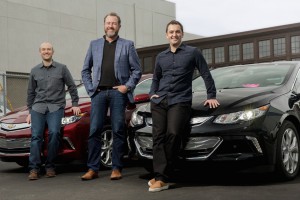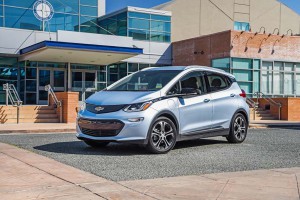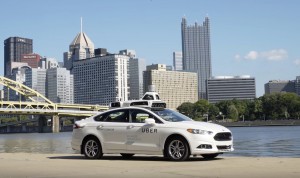
John Zimmer (r), with Lyft co-founder Logan Green (l) and GM CEO Dan Ammann, who recently took a seat on the service's board.
There’s a revolution coming, and it’s likely to bring major changes to the world of transportation over the next decade, says John Zimmer, president and co-founder of the country’s second-largest ride-sharing service, Lyft.
Like its bigger rival, Uber, San Francisco-based Lyft hopes to move the driver out of the front seat within the next five years, driving down costs and making it cheaper and easier for people to use a ride-sharing service than owning their own car.
“The good news is we don’t have to keep building our country around car ownership,” Zimmer wrote in a blog post over the weekend. Much the way you can stream music and videos, “you no longer need to own a product to enjoy its benefits,” suggested the 32-year-old entrepreneur. “Eventually we’ll look at owning a car in much the same way.”
Zimmer is by no means the only one who envisions a very different transportation industry in the near future. In fact, Jason Kalanick, head of rival Uber, has been pushing hard to adopt autonomous and, eventually, fully driverless vehicles. Just last week, in fact, Uber invited journalists to check out a small fleet of self-driving prototypes it plans to test on public roads in the Pittsburgh area.
(Click Here for more on Uber’s autonomous test program.)
While significantly smaller, Lyft also intends to move into driverless technology and it has a deep-pockets partner willing to assist. Just last January, General Motors invested $500 million in the ride-sharing service – though Lyft reportedly rejected a subsequent, $6 billion offer to purchase the service outright.
Like many rivals, GM also sees a transportation revolution in the making, one that could mean fewer retail customers, especially in denser urban environments. It has been investing heavily in ride and car-sharing operations, including the creation of the Maven service earlier this year. And GM says it specifically designed the new Chevrolet Bolt battery-electric vehicle to have strong appeal to services like Lyft.
It plans to offer drivers a low-rate lease program once the Bolt comes to market later this year. But it is also working on advanced autonomous systems and, eventually, fully driverless technology.
So is Detroit’s second-largest automaker, Ford, which recently announced plans to have a fully driverless vehicle in production, and targeted to ride-sharing and delivery services, by 2021.
(Click Here to see what it’s like riding in an autonomous Ford.)
In his blogpost, Lyft’s Zimmer positioned this as the third U.S. transportation revolution. The first came with the creation of canals and railroads that could hasten products to market. The second was fostered by Henry Ford’s development of the moving assembly line.
But private vehicle ownership comes at a price. For most Americans, an automobile is the second most expensive consumer good they ever will buy, and MSRPs have been rising fast in recent years. Add factors like traffic congestion and parking and many experts, including Ford CEO Mark Fields, anticipate a shift in attitude.
“We see car ownership as a burden that is costing the average American $9,000 every year,” wrote Zimmer. “The car has actually become more like a $9,000 ball and chain that gets dragged through our daily life. Owning a car means monthly car payments, searching for parking, buying fuel, and dealing with repairs.”
Right now, tens of thousands of Americans are working, at least part time, for the various ride-sharing services. And that figure is actually expected to grow over the next few years as more people start using these alternatives. In his post, Zimmer held out something of an olive branch, suggesting that there will still be need for some humans behind the wheel going forward.
But how many is uncertain, and not just in this world of taxi alternatives. Many proponents believe that both long and short-haul trucking will be a prime candidate for full automation in the years ahead.
Not everyone is as optimistic. Critics point to the fatal Florida crash of a Tesla Model S running in Autopilot mode, and to the numerous, more modest crashes involving autonomous Google prototypes. But they largely see such technologies taking longer to come to market, rather than not coming at all.
It may not be 2021 when Uber, Lyft and others get the first driverless cars on the road, but even most skeptics agree this third transportation revolution is coming.
(Start-up has a $999 system that could make your car drive hands-free. Click Here for more on comma.ai.)


